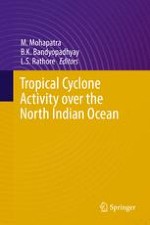2017 | OriginalPaper | Buchkapitel
Hydro-Meteorological Aspects of Tropical Cyclone Phailin in Bay of Bengal in 2013 and the Assessment of Rice Inundation due to Flooding
verfasst von : Kamaljit Rays, M. Mohapatra, K. Chakravarthy, S. S. Ray, S. K. Singh, A. K. Das, B. A. M. Kannan, B. K. Bandyopadhyay
Erschienen in: Tropical Cyclone Activity over the North Indian Ocean
Aktivieren Sie unsere intelligente Suche, um passende Fachinhalte oder Patente zu finden.
Wählen Sie Textabschnitte aus um mit Künstlicher Intelligenz passenden Patente zu finden. powered by
Markieren Sie Textabschnitte, um KI-gestützt weitere passende Inhalte zu finden. powered by
